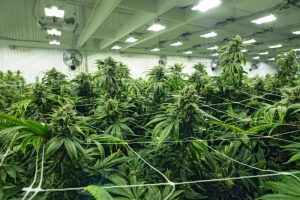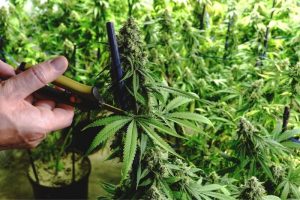Ever wondered why cannabis growers try to keep their plants short when they can grow very tall in length?
OR
Why vertical growth of the plant put growers at a disadvantage?
Answer to your query, before all else, is that cannabis plant grows vertically, is skinny in format and have one main stem in their prime focus. It has minimal lateral growth when it grows on its own, and the yield is tiny.
And getting the best yield possible is the GOAL of every grower!
To achieve this goal, growers manipulate cannabis plants; they train them using techniques such as topping. These techniques re-purpose the plant for broader and bushier plants rather than skinny and tall. Ultimately, a plant gets a higher number of colas and more psychoactive content.
What Is Topping?
Because you don’t want vertically growing, skinny babies with little yield, you snip off the top of the main stem to widen out the bottom of the plant. It is called the topping of the cannabis plant.
Topping will increase the off-center growth of plants.
Through this mechanism, you try to invest Auxin, a plant hormone, in the plant during a vegetative period that will cause fuller buds in the flowering stage.
Repurposing Auxin—More colas
All plants rely on hormones that dictate them the next events that are to occur. Auxin is one such hormone that has the authority over stem elongation. It fosters apical dominance and downgrades the growth of lateral buds.
But to keep the structure and body of the plant in tone, auxin has to level out between all the heads and not just the main stem.
When you cut the apex, the auxin production lowers.
After some days, the plant assumes the node below the cut as the apex and starts treating it like one, resulting in steady lateral growth.
Get the Time Right—For the Right Tone

Timing plays an important role here.
The vegetation period sets the tone for the yield of the cannabis plant.
You, so often, will see cultivators applying this simple yet effective horticulture technique to the newly thriving cannabis babies during 4-6 weeks of their vegetative growth.
During this time, the plant growth takes off to the new height, growing an inch or two and adding more stem and leaves every other day.
You do not do the topping until the plant is ready enough. A plant that has 4-6 nodes is ready for its first topping.
Usually, at this stage, the upper stem is concentrated, which is BIZARRE.
This causes a plant to expand upwardly rather than distributing its energies in getting a better canopy coverage.
So, you spice things up by cutting the apical stem of a plant!
And, for the last topping, you should prune the plant a week or two before the flowering stage, so the plant can recover from the shock, develop new cola sites, and happily enter the flowering period.
What you’ll need?—the Gear
There is no secret gadget to prune the stem; a nice pair of sharp scissors will do the task smoothly.
If you are feeling a little fancy, pruning/garden snips can be a fine addition to your arsenal. If you don’t have such scissors at hand, pull out some razor blades or rely on your hands for this.
BE CAREFUL.
We don’t want a broken stem; we want a sharp cut. Plant recovery takes more time when it’s broken. To be on the safe side, disinfect the pruning snip before use.
Bacteria and fungi creep around those cut edges, so using plant sealing paste can help here.
Because Contamination Sucks!
How it’s Done?—Topping and Training

Topping the cannabis plant is as simple as it sounds.
Count the nodes on your cannabis plant, and YOU have a choice of topping to the fourth, fifth, or sixth node. You go all the way from the base of the plant to the upper part, counting them.
The idea is to leave the fourth node when going to ‘top to fourth node’ and chop off all the above portion of the stem.
Now, take the garden snip and the main stem in your hands to make the sharp cut.
Remember this; the cut isn’t made directly at the node. Leaving an inch or two above the node will allow the plant to recover better and reduce any chances of contamination.
Here comes the best part.

By doing so, you have successfully removed the apex, and the below node will achieve dominance on its behalf. The two growth points at this node will act as the main stem from now onwards, and the main stem you just sliced off will show no more growth.
The lateral buds will grow and produce fresh shoots. These new shoots will extend horizontally into space and compete for the lead growth in the coming weeks after pruning.
In short, Topping plants upon recovery offer more bud sites.
A plant has to go through multiple such training sessions to maximize the output.
The outcomes—Positive!

The plant goes into a shock after the topping procedure, and it has to work itself out of the sudden changes in plant hormone and re-adjust according to the new stimulus.
Once done, you’ll see lateral meristems coming out of their chambers, adding more girth and thickness to the overall structure.
This way, you have doubled the number of main stems; we cut one, and two appear on its behalf.
HANDS IN THE AIR!
In the later flowering stage, these bud sites will develop into small but plenty of flowers that will lead to a fuller canopy and HIGH YIELD…which means more weed gummies to devour on.
In the Aftermath of Topping
It’s not just the lateral growth that gets better with the topping of the cannabis plant.
Air-flow gets better within the plant.
Sunlight reaches better to the axillary buds and the not-so-crowded branches underneath.
Also, energy is extensively and equally distributed among those nodes once you cut off those unnecessarily peeking heads.
Laying down otherwise vertical bud sites can also result in more bud sites getting exposed to the sun, and when the flowering period kicks off, you will welcome loads of buds to save your day.


